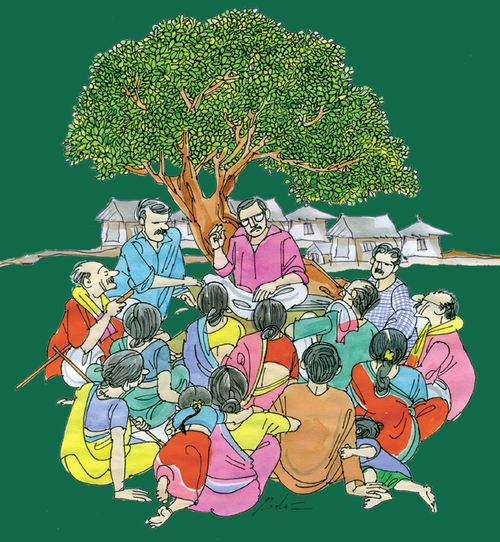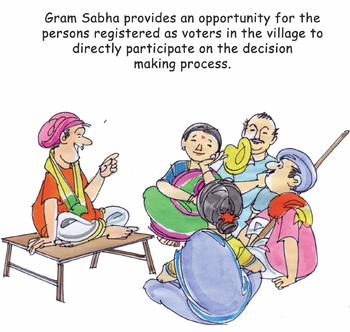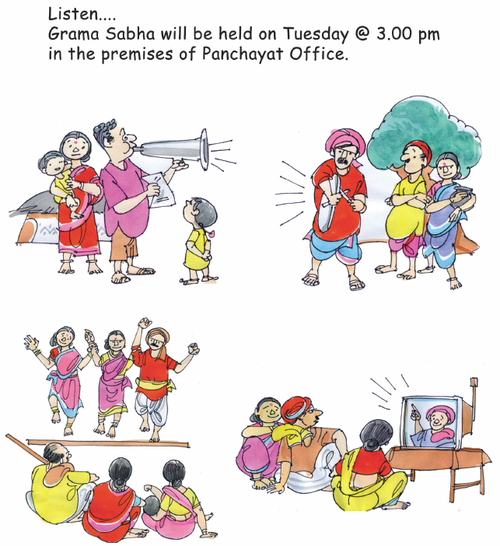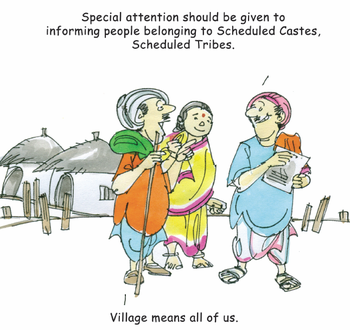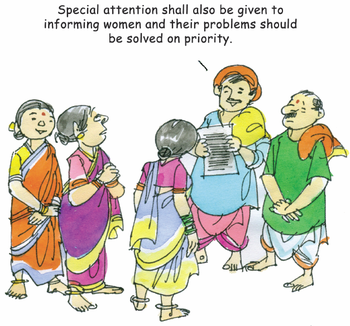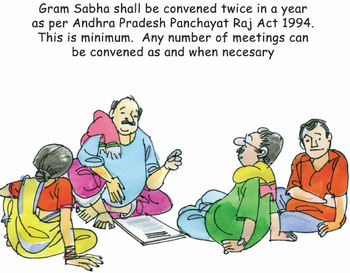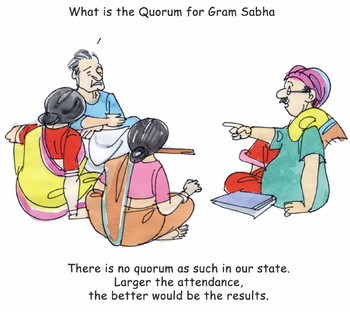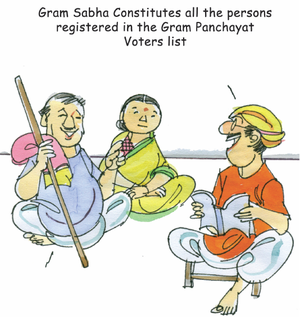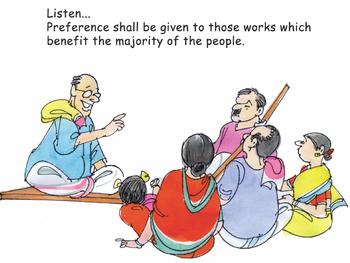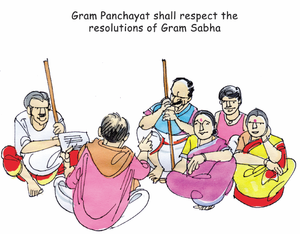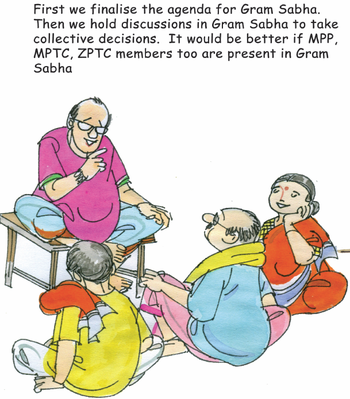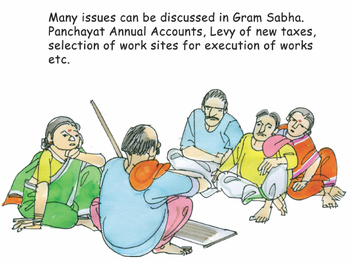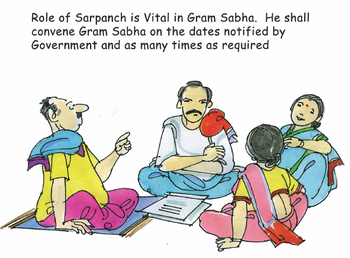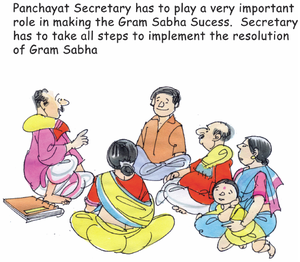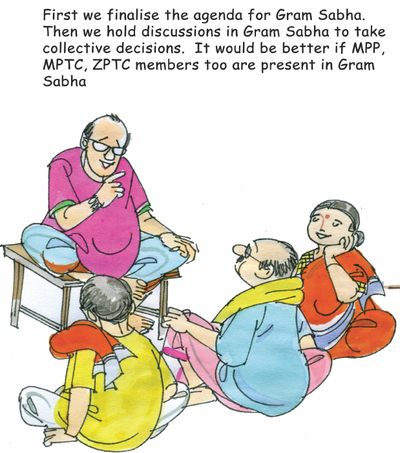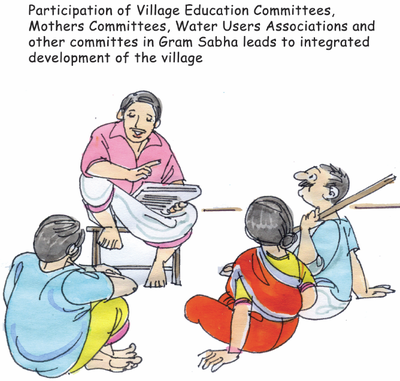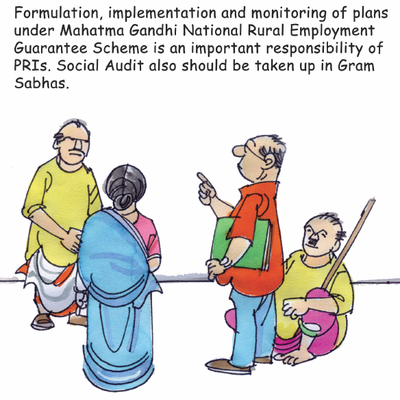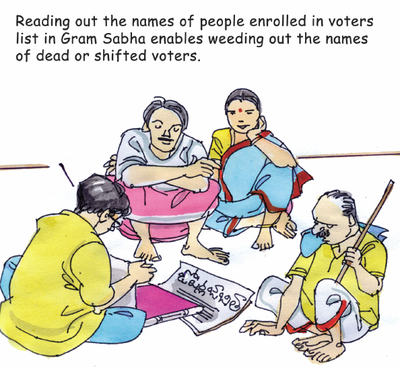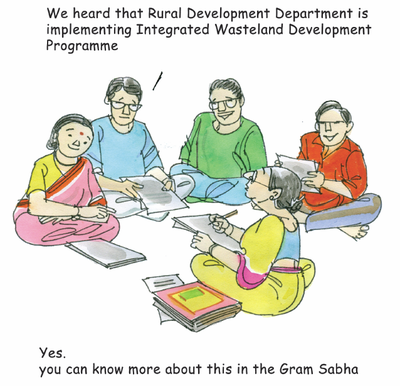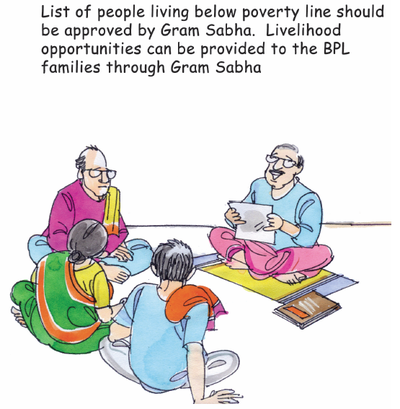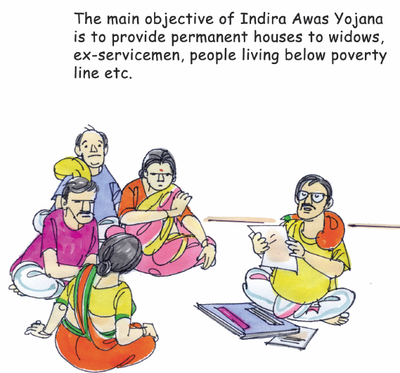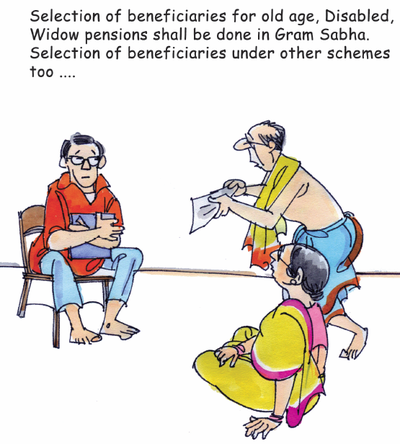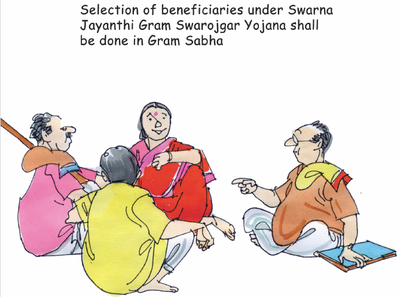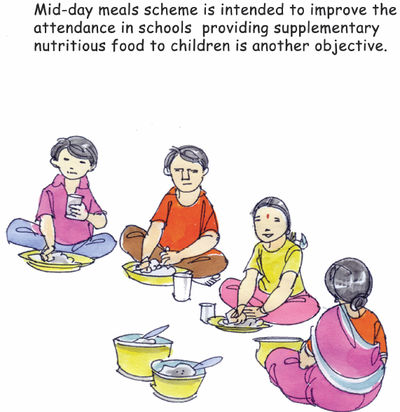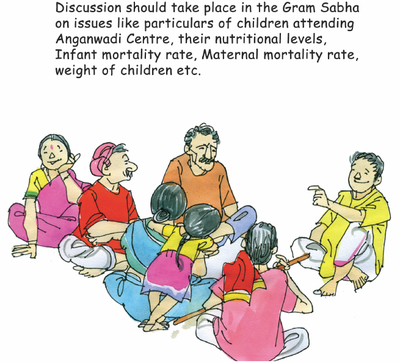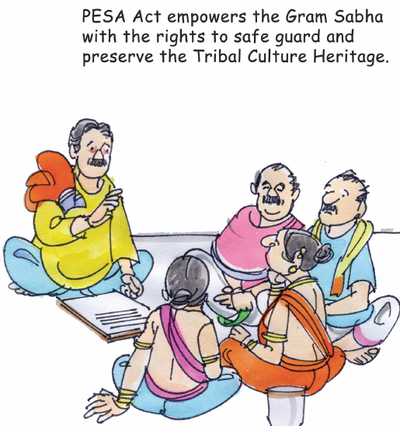Apard/Gramsabha
Contents
- 1 Grama Sabha
- 1.1 What is Grama Sabha
- 1.2 Gram Sabha as APPR Act
- 1.3 Who are not the members of Gram Sabha
- 1.4 Venue, Time and Place for holding Gram Sabha
- 1.5 Who Organises a Gram Sabha
- 1.6 Issuing of Gram Sabha Notice
- 1.7 Publicity for Gram Sabha
- 1.8 How to ensure proper participation of people belonging to scheduled castes,scheduled tribes, weaker section in Gram Sabha?
- 1.9 How to ensure participation of women in Gram Sabhas
- 1.10 How many Gram Sabha Meetings in a year ?
- 1.11 Quorum for Gram Sabhas
- 1.12 Who presides over the Gram Sabha
- 1.13 Participants of Gram Sabha
- 1.14 Prioritisation Principles
- 1.15 How to approve the Resolutions in Gram Sabha
- 1.16 Gram Sabha Agenda
- 1.17 Records to be maintained
- 1.18 Postponement of Gram Sabha
- 1.19 Language for proceedings
- 1.20 Relations between Gram Sabha and Gram Panchayat
- 1.21 Role of Sarpanch in Gram Sabha
- 1.22 Role of Panchayat Secretary in Gram Sabha
- 1.23 Role of Ward Members and MPTC Members
- 1.24 Roles of Mandal and Divisional Officials
- 1.25 Role of Staff of Various Departments
- 1.26 Role of Self Help Groups / Committees in Gram Sabha
- 1.27 Role of Members of Gram Sabha
- 1.28 Role of Gram Sabha in the implementation
- 1.29 Mahatma Gandhi National Rural Employment Guarantee Scheme
- 1.30 Validation of Electoral Rolls
- 1.31 Water Shed Programmes
- 1.32 Identification of BPL Families
- 1.33 Indira Awas Yojana
- 1.34 Selecting beneficiaries under various pension schemes
- 1.35 Swarnajayanthi Gram Swarojgar Yojana
- 1.36 Mid-Day Meals Scheme
- 1.37 Integrated Child Development Scheme (ICDS)
- 1.38 Gram Sabha in Scheduled Areas
- 1.39 Are there any villages which conduct Gram Sabha successfully?
Grama Sabha
The 73rd and 74th Constitutional Amendments have conferred the right on every registered voter to directly participate in Governance. The Gram Sabha and Ward Sabhas are the institutionalized foundations for decentralized participatory democracy. The Gram Sabha and Ward Sabha have to play a key role in rendering the Gram Panchayat transparent and directly a accountable to the people. The Grama Sabha is a means to solve people’s problems and felt needs and to decide how to use the available resources optimally in ways desired by them, to benefit the poorest in the village through direct democratic and participatory planning. The role of Gram Sabha is vital in bringing good governance in the local self governments. The ground reality reveals that the way the Gram Sabhas are conducted is not accordance with expectations. There appear to be several reasons for this situation. The main reasons seems to be the lack of awareness amongst the elected representatives of PRIs, Ritualistic conduct of the Gram Sabha, information about the Grama Sabha meeting not reaching the people well in advance, sparse attendance at the Gram Sabha, and a lack of cleared understanding amongst the people about the importance and the functions of Gram Sabha. The Planning Commission of India issued guidelines for preparation of decentralized district plans in a bottom-up approach during the 11th Five year plan in the month of August 2006. The guidelines clearly indicated that the village development plans should be prepared by people in a participatory mode through Gram Sabhas. The Union Ministry of Panchayatiraj, in its efforts to strengthen the institution of Gram Sabha and improve awareness among the citizens, requested the states to observe the year 2009-10 as the year of the gram sabha and to organise awareness campaigns from October 2nd of 2009 to December 2nd of 2010.
What is Grama Sabha
Article 243 (A) of the Constitution of India inserted by 73rd Constitutional amendment act describes the composition of Gram Sabha and According to this Article, Gram Sabha is the body consisting of all persons registered in the electoral rolls of a Gram Panchayat. The Article 243D also states that a Gram Sabha possesses all the powers endowed on it by various Acts and Rules issued by the State Government. Thus the 73rd and 74th Constitutional Amendment Acts have provided an opportunity for the persons registered as voters in the village to directly participate in the decision making process. Gram Sabhas/Ward Sabhas are the foundations to the decentralized democratic system and play a crucial role in ensuring a transparent and accountable administration by Gram panchayat. It can be said that the Gramsabha acts as a watch dog in the interest of village communities by monitoring the functioning of gram Panchayat. While the elected representatives like MPs in Lok Sabha, Rajya Sabha MLAs in State Assemblies take policy level decisions on behalf of the people , the registered voters in the village take part in the decision relating to the development of the village in the gramsabha with the help of Gram Panchayat and officials concerned.
Gram Sabha as APPR Act
The Andhra Pradesh State has implemented the constitutional provsions regarding gramsabha in letter and spirit and necessary provisions were incorporated in the State Panchayat Raj Act 1994 through Section 6. The AP PR Act defines the Gram Sabha as a body constituting all the persons registered in the electoral rolls of a Gram Panchayat, All the registered voters within the purview of a Gram Panchayat are considered as members of Gram Sabha. In accordance with the provisions contained in the section 6 of APPR Act 1994, the Panchayati Raj and Rural Development Department has issued detailed guidelines for conduct of Gram Sabhas through GO M.S. No. 367 dated 28.8.1998 .
Who are not the members of Gram Sabha
People below the age of 18 years are not the members of Gramsabha. Persons, those who are above 18 years and living in the village but not enrolled in the Gram Panchayat Voters list are also not the members of the Gram Sabha.
Venue, Time and Place for holding Gram Sabha
Gram Sabha should be conducted within the purview of GP at a place convenient for all the members to sit. In case of multiple villages under a GP, Gram Sabha may be conducted on rotation basis in all the villages one after the other. Gram Sabha can be conducted anytime during day time i.e., after sunrise and before sunset.
Who Organises a Gram Sabha
According to Sec 6(5) of the APPR ACT, 1994, the Panchayat Secretary should organize the Gram Sabha. Gram Panchayat Sarpanch has to convene a Gram Sabha meeting when either 10% members of Gram sabha or 50 persons of Gram Sabha (whichever is more) submits theri requisition for holding a Gram Sabha However, those members have to inform the purpose for the meeting. A written request for the meeting must be handed over to the Sarpanch during office hours 5 days before the date of meeting. If the Sarpanch fails to hold the meeting on the requested date, the members who requested the meeting can themselves organize the gramsabha meeting.
Issuing of Gram Sabha Notice
The purpose, time and place of Gram Sabha meeting must be intimated through a notice giving at least two days prior information. It follows that the Gram Sabha can be conducted only after a proper notice of purpose, place and time of Gram Sabha is issued. Government Order GO no. 367 has suggested three methods for issue of notice of Gram Sabha. They are 1. Making public announcement, 2. Displaying public notice at three main places in the village, 3. Displaying the notice in the Notice Board of Gram panchayat office building. Either one of these methods should be strictly adhered to by the Gram panchayat sarpanch. Gram Panchayat shall take all possible steps to ensure greater participation of villagers in Gram Sabha depending upon the circumstances prevailing in the village.
Publicity for Gram Sabha
Apart from traditional way of notifying the conduct of Gram Sabha, the following methods can also be adopted for the same for wide publicity: display of wall posters, house to house canvassing, propagating through cultural troupes electronic and print media and public address systems at various places. The School teachers may be advised to communicate the gram sabha meeting schedule through the children to the parents. The information can also be spread widely through the village level official functionaries like Aangan wadi worker, Health Department Staff etc. The services of farmer clubs, women self help groups, progressive farmers, Water Users Associations, Mothers’ committees, Vana Samrakshana Samithis, youth Associatons, and Community Elders may be utilized for mobilizing large numbers.
How to ensure proper participation of people belonging to scheduled castes,scheduled tribes, weaker section in Gram Sabha?
While preparting village development plans, focus should be given for the upliftment of people belonging to Scheduled Castes, Scheduled Tribes, Backward classes and other weaker sections . We have to ensure their better participation in the gramsabha meeting and provide an opportunity for them to freely express their felt needs and grievances. In order to ensure their better participation, the information regarding the conduct of gram sabha should be extensively propagated in areas inhabited by Scheduled Castes, Scheduled Tribes and other Weaker Sections. If their grievances are redressed before the next Gram Sabha meeting, their faith on gramsabha will increase and they show more interest for attending Gram Sabha meetings regularly.
How to ensure participation of women in Gram Sabhas
Normally, the attendance of Women in Gram Sabhas is very poor, and even if they attend, they find it difficult to express their opinions and put forward problems pertaining to women due to lack of congenial circumstances. Though the women self help groups in our State have formed into village level groups and are interacting on issues like Savings, Loans etc, they are still hesitant to openly participate in Gram Sabhas. In these circumstances, the Gram panchayat should take initiative and ensure wider participation of Women in gram sabhas by active propagation through Women Self help groups and Village Organisations.This can be taken up with the assistance of Women ward members and other members . Women specific problems should be discussed and steps should be taken to resolve them. To involve women in the process of decision making in Gram Sabhas, separate Women Gram Sabhas are being conducted prior to Gram Sabha meetings in the State of Maharashtra . This ensures proper resolution of Women related issues.
How many Gram Sabha Meetings in a year ?
According to Sec 6 (3) of APPR ACT, the meeting of Gram Sabha should compulsorily be held for two times in a year. The Government has also notified the two dates on which the meeting to be held compulsorily. The Gram Sabha meeting should be held on every 14th April and 3rd October. Conduct of gramsabha yearly twice is a minimum, not maximum. Gram Sabha can be convened as and when necessary and as many times as possible depending on the need. In, States like Andhra Pradesh, Arunachal Pradesh, Bihar, Karnataka, Punjab, Sikkim, Uttar pradesh there are statutory provisions to hold the gram sabha two times a year, Where as in states like Assam, Goa, GUJARAT, HIMACHAL PRADESH, KERALA, MADHYA PRADESH, TAMILNADU, ORISSA, CHHATTISGARH, RAJASTHAN, Gram Sabhas are being held 4 times a year. Gram Sabhas are being held 6 times in a year in Maharastra and 3 times in Haryana.
Quorum for Gram Sabhas
The minimum number of members to be present for holding gram sabha meeting is called QUORUM. The APPR ACT has not laid down any minimum number of members as quorum for Gram Sabha meetings. The quorum for gramsbha varies across states. The gramsabhas in Tamilnadu, Orissa, Rajasthan, Kerala, Karnataka, Haryana, Gujarat, Goa, Assam, Bihar require a quorum of 10% of the total gramsabha members, where as gramsabhas in Uttar Pradesh and West Bengal require 5%. States like Maharastra, Himachal Pradesh, Madhya Pradesh have prescribed relatively large quorum of 15%, 20%, 33.33% respectively. It may however be noted that more the attendance at Gram Sabhas, effective would be the discussion on various issues and problems related to the people and out come would be meaningful.
Who presides over the Gram Sabha
The Sarpanch of Gram panchayat Shall preside over the gramsabha. In case of absence of Sarpanch, Upa Sarpanch shall preside over the gramsabha.
Participants of Gram Sabha
The following categories of people can participate in gramsabha, Registered voters in the Gram panchayat
- Sarpanch of Gram Panchayat, Panchayat Secretary, Ward Members,and Co-opted members of Gram Panchayat.
- Mandal Parishad Development Officer, Mandal Tahsildar, Village Development and Panchayati Raj Development Officer, District Panchayat Officer, Divisional Panchayat Officer, and all the village and mandal level officials working in the developmental and Welfare Departments .
- MPTC Members, MPP, ZPTC, Local MLA, MLC, Local MP (Rajya Sabha and Loksabha)
- All voluntary Organisations and Civic Right Committees within the purview of Gram Panchayat.
- Commissioner of Panchayat Raj, District Collector, District Panchayat Officer, and District level Officers can also attend , subject to their convenience.
How ever, the voting rights remain with only the members of Gram Sabha.
Prioritisation Principles
The gap between the demand and the actual availability of funds for undertaking development projects will always be very wide and in such cases the Gramsabha has to prioriitise the felt needs of the people. Gram Sabha while prioritizing the felt needs has to follow certain principles to prioritize by selecting (1) those works which are beneficial to majority of the people, (2) those works which benefit the marginalized groups like Scheduled Castes, Scheduled Tribes , differently abled persons, women etc. In case of two or more solutions are available for any problem/issue, the one which costs less should be given priority.
How to approve the Resolutions in Gram Sabha
The Gramsabha Members can give their approval for the resolutions by raising their hands. Opinion of the Majority Members should be considered for acceptance of the resolution.
Gram Sabha Agenda
The issues that are proposed to be discussed during the gramsabha are to be incorporated in the agenda. Gramsabha may discuss any issue related to the development of the Village. However, Section 6 (3) of the APPR ACT specially states the following six issues that can be discussed in a Gram Sabha:
- Annual statements of accounts/ audit report, audit note and replies to them.
- Report on the administration of the preceding year.
- The budget prepared by the Gram Panchayat and the future development programs and plans.
- Proposals for fresh taxation or for enhancement of existing taxes
- Selection of schemes/ beneficiaries/ locations and identification of beneficiaries for the implementation of various development programs.
- Any other issues ordained by the Government apart from the above listed issues, Gram Sabha shall also discuss the following issues as listed out by Government Order (G.O.) No. 367:
- Agriculture developmental Schemes pertaining to the village.
- Working efficiency of the staff of Gram Panchayat.
- Utilisation of Loans
- Working efficiency of defence and shraamik banks.
Records to be maintained
The Panchayat Secretary shall maintain two types of records in Gram Sabha. They are: (1) A register to record the notice of meeting and Minutes of the meeting, and (2) A register to obtain signatures/thumb impressions of members attending the meeting.
Postponement of Gram Sabha
A Gram Sabha can be postponed. However, the approval of the members present for the Gram Sabha must be obtained for the postponement.
Language for proceedings
The proceedings of the Gram Sabha shall be in the main language of the village.
Relations between Gram Sabha and Gram Panchayat
Though the APPR ACT does not make it obligatory for the Gram Panchayat to implement the resolutions taken at a Gram Sabha, members of majority of Gram Panchayats in Andhra Pradesh feel it right to give utmost prominence to Gram Sabha resolutions. It’s a good tradition to respect the resolutions of a Gram Sabha. People will start believing in the system of Gram Panchayat when they recognize that the resolutions of Gram Sabha are being valued and implemented by Gram Panchayat. This will result in regular attendance of people to Gram Sabhas.
- Action programs of cooperative socities.
- Issues relating to list of porambok lands under the control of Gram Panchayat.
- List of transfer of residential and other immoveable properties.
- List of defaulters of taxes to the Gram Panchayat may also be
discussed in Gram Sabha.
Role of Sarpanch in Gram Sabha
Sarpanch is legally bound to organize Gram Sabha meetings. It is an obligatory duty of Sarpanch to organize a minimum of two Gram Sabha meetings every year on the dates prescribed by the Government. Sarpanch should preside over the Gram Sabha meetings. Sarpanch should sign the register meant for recording the minutes of Gram Sabha meeting. As the chairperson of the Gram Sabha meeting, the Sarpanch can answer the questions raised at the Gram Sabha by the members. The sarpanch has to ensure that the suggestions made in the Gram Sabha meeting, are discussed on priority basis in Gram Panchayat meetings. Sarpanch should play a pro active role for initiating proper action on the gramsabha resolutions. Sarpanch should take steps to ensure larger participation of people at Gram Sabha meetings. Sarpanch should take all measures to ensure participation of people from all sections of society mainly, Scheduled Caste, Scheduled Tribes, Women, and he should encourage them to express their grievances and give suggestions in the Gram Sabha, which are discussed in detail in the next meeting. In case if any Sarpanch fails to convene the gramsabha meetings twice a year as stated in the G.O. 367, the Sarpanch will cease to hold the post. Such provisions are incorporated in AP Panchayat Raj Act Sec 20(A)(1). According to this section, such Sarpanch will not be eligible for contesting for a period of one year from the date of losing the post.
Role of Panchayat Secretary in Gram Sabha
The role of Panchayat Secretary is vital at Gram Sabha. The duties of Panchayat Secretary can broadly be categorized into three stages: (1) Pre-Gram Sabha, (2) During Gram Sabha, and (3) Post Gram Sabha.
Pre Gram Sabha duties
The pre Gram Sabha duties of Panchayat Secretary include:
- Finalisation of agenda for Gram Sabha in consultation with the Sarpanch.
- Issuing notice of Gram Sabha meeting.
- Publicising widely the Gram Sabha meeting details, such as the date,time and venue.
- Preparing the Action Taken Report on the resolutions of the previous Gram Sabha meeting.
- Preparation of notes on the agenda items to be placed before the current Gram Sabha meeting.
- Providing proper seating, drinking water facilities and sanitation facilities for people attending the Gram Sabha meeting.
Duties during Gram Sabha
The duties of Panchayat Secretary during the conduct of Gram Sabha include:
- Recording the details of members attending the meeting of Gram Sabha.
- Presenting the Action Taken Report on resolutions of previous Gram Sabha meeting.
- Ensuring the smooth conduct of the meeting of Gram Sabha as per its Agenda.
- Assisting the Sarpanch in recording the minutes of Gram Sabha.
- Recording of votes casted in favour/against of any resolution placed before Gram Sabha
Post Gram Sabha duties
These include- To coordinate with the Sarpanch and ward members for considering the resolutions of Gram Sabha in Gram Panchayat meetings. To send report on the Gram Sabha meeting to the higher officials concerned.
Role of Ward Members and MPTC Members
All the Ward members should compulsorily attend the meetings of Gram Sabha. The Ward members should play a proactive role for finding the solutions for the issues relating to their respective wards and the village as a whole. They should take proper care to ensure that all the eligible beneficiaries are properly identified in the Gram Sabha. They should motivate people to attend Gram Sabhas in large numbers. The Ward members should take lead in placing the problems and needs of villagers at Gram Sabha. They should ensure that the discussions at Gram Sabha are in accordance with agenda of Gram Sabha. They should not show any personal bias or nepotism, while selecting the beneficiaries and respect the spirit of Gram Sabha resolutions. The ward members should facilitate expression of views by all sections of people at Gram Sabha. The MPTC Member elected from the village and representing the village should also attend the Gram Sabha. The MPTC member has to note down those issues which fall out side the purview of the Gram Panchayat and comes under the functional domain of Mandal Parishad and coordinate with the other Members of the Mandal Parishad, MPP and MPDO to place them before the General Body Meeting of Mandal Parishad, due consideration.
Roles of Mandal and Divisional Officials
For smooth and proper conduct of the compulsory Gram Sabha meetings of April 14th and October 3rd of the prevailing Government Order, the Divisional Panchayat Officer, in coordination with the Mandal Parishad Development Officers, Tahasildars under his purview, should draw up a list of available officials and take steps to depute them to attend the Gram Sabha meetings. All these arrangements should be in place at least one week before the conduct of the Gram Sabha meetings, i.e., by April 7th and September 25th for the respective meetings. The officials so deputed will act as advisors to Gram Panchayat and will assist in the proper conduct of Gram Sabha meetings. Apart from these mandatory Gram Sabha meetings, these officials will play a similar role during other Gram Sabha meetings too.
Role of Staff of Various Departments
Staff from various Government Departments should attend the Gram Sabha equipped with latest progress Reports. They can reply to the questions of participating members, concerning village development. They should encourage to impartially select the beneficiaries of scheme pertaining to their department. They should bring to the notice of Gram Sabha any difficulties that they face in discharging their duties and should try to find a solution for it.
Role of Self Help Groups / Committees in Gram Sabha
Departments like Rural Development, Agriculture, Education, Health, RWS etc have created certain committees with in the jurisdiction of the Gram Panchayat for the purpose of implementing certain schemes or programmes. The most important among these committees working in the jurisdiction Gram panchayat are:
- Water Users Associations
- Village Education Committees
- Mothers’ committees
- Village organization of Women self help groups
- Village Drinking Water and Sanitation Committee
- Village Health and Sanitation Committee
- Watershed Committee
- Vana Samrakshana Samithis.
As all these committees carry out activities which are confined only to the specific programmes. Therefore Gram Sabha is a good forum to bring synergy among various committees to have a proper horizontal linking for successful implemention of their programmes with the help of other Committees. For example the Village Health and Sanitation Committee has to coordinate with the Village Water and Sanitation Committee as the drinking water has a direct bearing on the public health. Such coordination is only possible if sarpancha takes an initiative through Gramsabha. These Committees can also strive to improve the attendance at Gram Sabhas.
Role of Members of Gram Sabha
Every registered voter in Gram Panchayat shall attend the Gram Sabha meeting to make it an effective instrument for seeking solutions to their day-to-day problems. They shall come prepared to discuss the various issues related to community as a whole. The members shall openly discuss about the genuineness of the beneficiaries to be selected under various schemes and ensure that the poorest among the poor gets selected The members shall assist the Gram Panchayat in prioritizing the developmental works for the village. They shall be eager to contribute in the form of money or in the form of labor whenever requested by the Gram Panchayat for the development of Village. The members shall participate in the Gram Sabha discussions and seek any clarification regarding the functioning of Gram Panchayat or on any developmental works taken up by the Gram Panchayat. They should encourage fellow members especially members belonging to Scheduled Castes, Scheduled Tribes and backward communities to attend the Gram Sabha meetings.
Role of Gram Sabha in the implementation
Role of Gram Sabha in the implementation of the various Programmes. While the Gram Sabha is being organized in accordance with the guidelines issued under the Panchayati Raj Act, it has also to be organized in accordance with gudelines of various state and centrally sponsored schemes/ programmes.
Mahatma Gandhi National Rural Employment Guarantee Scheme
NREG Act gives centrality to Panchayat Raj Institutions and it states that the PRIs are the Prinicipal Authorities to plan, implement and monitor the works taken up under NREG Scheme. Section 13 of the guidelines of the NREG Act clrearly states the roles and Gram Panchayat, Mandal Parishad, Zilla Parishad in its planning and implementation. The responsibilities of the PRIs are outlined in the section 13 of 17 of the NREGA. As per the NREG Act it is through the Gram Sabha that the wage seekers have to be informed and made aware of their rights and the Gram Panchayat to be made aware of their role and functions. Identifying, execution and monitoring of works, and conducting the Social audit has to be done through and by the Gram Sabha. The Vigilance Committee has to convey all its fundings to the Gram Sabha. The transparency in the programme implementation will be established through Social Audit by the gram Sabha. It is indeed true to say that no other programme has given so much centrality to the Gram Sabha as in NREGA.
Validation of Electoral Rolls
As a part of the electoral revision process of the Election Commission, the Gram Sabha has to verify the entries in the electoral list and validate the list, by announcing it in the Gram Sabha. The reading out of the list enables weeding out the names of people who have been absent for long time and those who have died. It also enables the names of people, whose names are not entered in the voters list. It is the responsibility of the Panchayat Secretary to organize the Gram Sabha on the dates indicated by the Election Commission.
Water Shed Programmes
The common watershed guidelines issed by the Ministry of Rural Development in 2008 have given central role to the Gram Sabha. The Watershed Committees are to be constituted through Gram Sabha. The selection/election of the President of Watershed Program should be through Gram Sabha. The detailed project report prepared by the Watershed Development Teams for the Development of waste lands should be placed before the Gram Sabha for its approval. The maintenance of assets created under this program, should be taken up by the Gram Panchayat and Gram Sabha. The Gram Sabha has to approve the norms for utilization of funds released for watershed development. One of the members from among SHG’s nominated by the Gram Sabha has to manage the Water shed development fund. The Detailed Project Reports prepared by Watershed Development Teams are to be placed before the Gramsabha for approval. The assets created under watershed programmes shall be maintained by the Gram Panchayat and the Gram Sabha. The Detailed Project Reports prepared by watershed development teams constituted under Integrated Wasteland Development Programme should also be placed before the gramsabha for approval.
Identification of BPL Families
In order to ensure that the benefits under developmental programmes/welfare schemes of the Government reach the eligible beneficiaries, the list of people living below the poverty line should be available with the Gram Panchayat and various Government departments. To enlist the details of families living below poverty line, the Union Ministry of Rural Development undertakes periodical surveys through DRDA. This survey will take in to consideration of 13 parameters which include land holding of each family, type of house they are residing in, number of clothing they have, food security, sanitation, food consumption patterns, literacy levels, labour force, means of livelihood, number of children, indebtedness, reasons for migration etc. As per the BPL survey rules the list of people living below poverty line should be placed in Gram Sabhas to confirm the list of families living below the poverty line. Since the list of people living below the poverty line is based on the information obtained from door to door enumeration, Gram Sabha is the forum which can debate on the genuineness of the information and can ensure that no body drops from the list who or otherwise eligible. As the selection of beneficiaries under various programmes will be done based on the BPL list, the grampanchayat should ensure that, the people attend the gramsabha in large numbers.
Indira Awas Yojana
Indira Awas Yojanaas a scheme aimed at providing housed to all BPL Families. This scheme being implemented by the union ministry of rural development, is meant primarily to help construction/upgradation of houses of members of SC/ST, freed bonded laborers, other below the poverty line non-SC/ST, widows and family members of defence personnel/paramilitary forces killed in action residing in rural areas (irrespective of their income criteria), ex-servicemen and retired member of paramilitary forces fulfilling the other conditions. This Scheme being implemented by the Ministry of Rural Development. The eligible beneficiaries of this scheme have to be selected in and by the Gram Sabha. Once the eligible beneficiaries have been identified by Gram Sabha and the list is prepared, no body else has the right to other or change the list. As per the recent guidelines issued by state government the list of the beneficiaries selected under INDIRAMMA housing scheme has also to be validated by the Gram Sabha
Selecting beneficiaries under various pension schemes
Selection of beneficiaries for Social Security Schemes like old age pensions, Disabled pensions, Pension for Widows, Pensions for handloom workers etc should be done through Gram Sabha. The G.O No. 83 dated 27.03.2006 and Memo no. 24235 /RDII/2006 dated 5.2.2007 issued by the AP State Panchayat Raj and Rural Development Department clearly defined the role of Gram Sabha in selecting the beneficiaries under these schemes. After careful inspection of all requests for sanction of pension received within the stipulated time period by the Gram Panchayat, the Panchayat Secretary should prepare the list of eligible pensioners. The list so prepared should be read out to the members of INDIRAMMA Committee and after duly registering the observations of the Committee and should later be placed before Gram Sabha for approval. Gram Sabha can suggest changes/alterations in the list after keen observation of the list. Gram Sabha can propose the names of eligible beneficiaries who are not included in the list. The Mandal Parishad Development Officer will sanction pensions to all those beneficiaries who are finalized by the Gram Sabha. In order to utilize the 100% saturation concept under this pension scheme, it has to be ensured that the members of gramsabha would attend in large mumbers and enlist all the eligible beneficiaries for various pensions after due deliberations.
Swarnajayanthi Gram Swarojgar Yojana
This is one of the important schemes which aims at reducing the poverty. The Gram Sabha has to identify beneficiaries from among those living below the poverty line, to engage them in individual and group self employment schemes. The selection of beneficiaries has to be done in the Gram Sabha by the MPDO, Bank Officer concerned, the Panchayat Sarpanch and others.
Mid-Day Meals Scheme
The objectives of the Mid day meals scheme are to enhance enrolment ratio in schools , reduce school drop outs, increase the attendance at schools, and to provide supplementary nutritious food to the children. The Gram Sabha can set up a group to examine on its behalf and report to at on the quality of the food supplied and cleanness in the cooking area and in the area where children eat their food. The team appointed to can also check whether timely procurement of Ingredients, fuel, etc. takes place or not and give its suggestions to gramsabha
Integrated Child Development Scheme (ICDS)
As per the G.O No. 41 (dt: 19.11.2008) of the Department of Child Welfare of AP Government, Gram Sabha should take up the social audit of the efficacy of the Integrated Child Development Scheme (ICDS). The Aangan Waadi worker should submit the ICDS progress report every two months to the Gram Sabha. Details of children attending the Aangan Waadi and their nutrition levels, child mortality, women mortality, weight of children, etc should be commented upon by the Aangan Waadi worker, in these reports. Based on these reports, the Gram Panchayat should discuss and take proper decisions at Gram Sabha
Gram Sabha in Scheduled Areas
The Central Government has extended the applicability of Panchayat Raj Act to Scheduled Areas with the introduction of PESA ACT In 1996. Under this Act, Gram Sabhas in the Scheduled Areas have acquired rights on management of natural and community resources apart from designing and implementation of developmental activities. The management and control of minor forest produces is also entrusted to Gram Sabhas. Gram Sabhas are also entrusted with the responsibility of safeguarding and preserving tribal culture and traditions Andhra Pradesh Government has brought out a conformtory Act (Act 7/1998), and defined the duties of Gram Sabhas (Sec 242 C) by amending the APPR ACT in 1998. According to this Section,
- Every Gram Sabha should be competent to safeguard and preserve
- The traditions and customs of the people,
- The cultural identity and community resources and
- The customary mode of dispute resolution without harming to any law.
- Every Gram Sabha should
- Approve plans, programmes and projects for social and
economic development, before it is taken up for the implementation by the GP.
- Responsible for the identification of selection of persons as
beneficiaries under poverty alleviation and other programmes.
- Every GP should obtain from the Gram Sabha, a certification of
utilization of funds by that Panchayat for the plans, programmes and projects. The detailed guidelines regarding the functioning of gramsabha in scheduled areas are yet to be issued by the government. However, the other provisions issued through G.O. Ms.367 will hold good even in scheduled areas.
Are there any villages which conduct Gram Sabha successfully?
There are many villages which have succeeded in involving the people in a participatory development programs through the Gram Sabha. In our State Gangadevipalli of Warangal District, Pandurangapuram of Kurnool district, Ramachandrapuram of Karimnagar District, Ankapur of NIzamabad district are some of the success stories. Similarly Hiware Bazar of Ahmadnagar district in Maharashtra is a good example.
Gangadevipalli Panchayat
The eighteen different Committees formed through Gram Sabhas in Gangadevipalli like, Drinking Water Committee, Sanitation Committee, Health Committee, Communications Committee etc, are providing exemplary services to its populace. This village has attained
- Total prohibition of consumption of liquor,
- 100% Enrolment in schools
- 100% literacy,
- Supply of protected drinking water to all families,
- Observance of family planning by all eligible couples,
- Vaccination of all children,
- 100% families enrolled in bank saving schemes,
- Total sanitation in the village.
Every villager would definitely find a place on at least one of the 18 committees. Any issue of development of the village has to be necessary discussed in the Gram Sabha. All are bound by the resolutions of Gram Sabha.
Hiware Bazar Panchayat
Inspite of Hiware Bazar being in the drought prone area, they have through the various decisions taken in Gram Sabha and the Gram Sabha ensuring the enforcement of its decision has managed successfully to construct watersheds and has today self sufficiency, which has resulted in dramatically increasing agricultural production of commercial crops like Onions, Jowar and limiting production of paddy to consumption needs only. The villagers accepted and implemented the decision of Gram Sabha not to grow water intensive crops like Sugarcane in view of long term interest of the village water needs, though sugarcane has a demand in the local market. This conscious decision for the long term interest of village to grow only less water intensive crops set the village on the path to development. This Gram Panchayat which twenty years ago was a victim of drought and social evils like alcohol addiction, is today a village which has achieved total prohibition, total sanitation, successful watershed implementation, receives country wide acclaim and all this success is due to the total involvement and participation of the people in the Gram Sabha.
Pimpri Gawali
Pimpri Gavali is model village in Maharashtra state. This village achieved water security in short span due to effective implementation of the Adash Gaon Yojana of the Government of Maharashtra. This village falls in the rainfed area of the Maharashtra. Gramsabha played crucial role for the participatory approach in watershed development activities. Grampanchayat had taken landmark decision to ban tubewells to avoid the exploitation of the groundwater through Gramsabha resolution entitled ' Groundwater Regulation and Management Resolution. Gramsabha also passed resolutions to ban liquor, ban for open grazing to protect forest, ban for open defecation etc.
